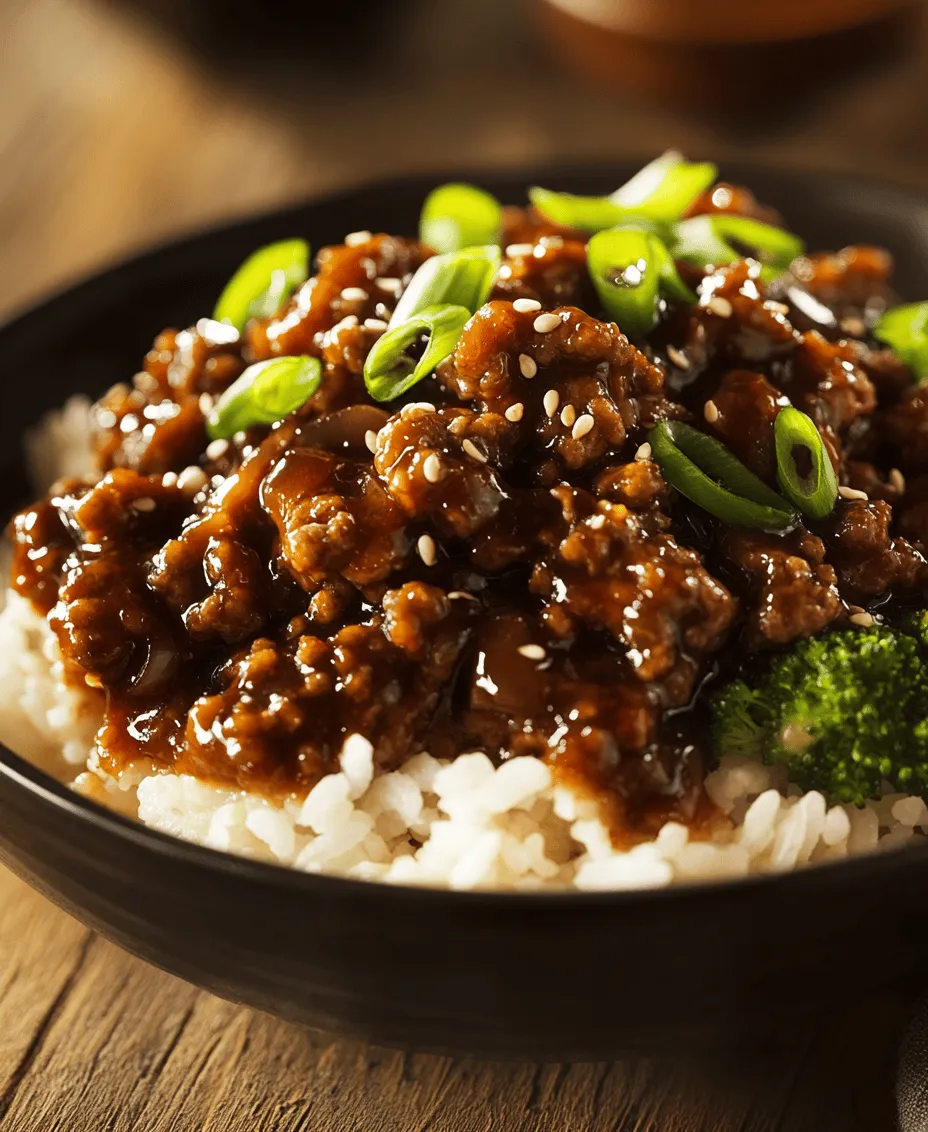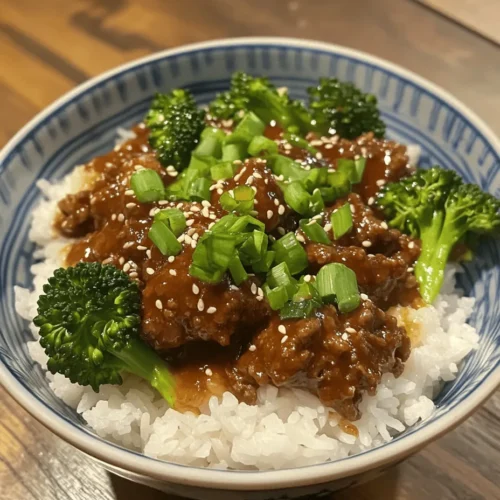Introduction
In recent years, Korean cuisine has surged in popularity, captivating food enthusiasts with its vibrant flavors and distinctive culinary techniques. Among the many delicious dishes that this cuisine offers, the Savory Korean Beef Bowl stands out as a perfect representation of Korean flavors, combining the rich taste of beef with an array of complementary ingredients. This dish is not just a feast for the senses; it is also a nutritional powerhouse, making it an ideal choice for busy individuals and families seeking a quick yet satisfying meal.
The Savory Korean Beef Bowl is a harmonious blend of sweet, spicy, and savory elements, delivering a well-rounded experience in every bite. With its simple ingredients and straightforward preparation, this recipe is accessible to both novice cooks and seasoned chefs. Whether you’re preparing a weeknight dinner or a meal prep option for the week ahead, the Savory Korean Beef Bowl is sure to impress. Its versatility allows for customization based on personal preferences, making it a staple in many households.
In this article, we will delve deep into the world of Korean cuisine, exploring the fundamental flavors and ingredients that define it. We’ll also break down the specifics of the Savory Korean Beef Bowl’s ingredients and provide clear, step-by-step cooking instructions to ensure your culinary success. So, let’s embark on this delicious journey into Korean cooking!
Understanding Korean Cuisine
Korean cuisine is renowned for its balance of flavors, vibrant colors, and health-conscious ingredients. At the heart of Korean cooking lies the concept of harmony among different tastes—sweet, spicy, and savory—creating dishes that are both satisfying and nourishing.
The Importance of Balance: Sweet, Spicy, and Savory
In Korean dishes, achieving a balance between these flavors is essential. Sweetness often comes from ingredients like sugar or fruits, while heat is introduced through various types of peppers, especially gochujang (fermented red chili paste). Savory notes are typically derived from soy sauce and fermented ingredients, such as kimchi. This intricate flavor profile not only makes each meal enjoyable but also provides a delightful culinary experience that keeps diners coming back for more.
Essential Ingredients in Korean Cooking
Korean cooking relies on a variety of ingredients that contribute to its signature taste. Staples include rice, vegetables, meat, and an array of sauces and pastes. Each component plays a crucial role in the overall flavor and texture of the dish. Familiarizing oneself with these staple ingredients is key to mastering the art of Korean cooking.
The Role of Gochujang in Korean Dishes
Gochujang is a central ingredient in many Korean recipes, including the Savory Korean Beef Bowl. This thick, red paste made from fermented soybeans, glutinous rice, and red chili powder adds depth, heat, and a hint of sweetness to dishes. Its unique flavor profile enhances the overall taste of the beef bowl, making it a must-have in your pantry if you’re exploring Korean cuisine.
Ingredients Breakdown
Understanding the role and flavor of each ingredient in the Savory Korean Beef Bowl is essential for achieving the desired taste. This section provides an in-depth look at the ingredients, ensuring you know exactly what to expect when preparing the dish.
Ground Beef: Choosing the Right Fat Content
The foundation of this dish is the ground beef, which brings richness and protein to the meal. When selecting ground beef, consider the fat content; a blend of 80/20 (meat to fat) is ideal for this recipe. This ratio ensures a juicy and flavorful result without being overly greasy. Ground beef is also quick to cook, making it a practical choice for a weeknight meal.
Sesame Oil: A Flavorful Foundation
Sesame oil is a staple in Korean cooking, known for its nutty aroma and rich flavor. In this recipe, it serves as a base for sautéing the beef and aromatics, infusing the dish with a distinctive taste. The use of toasted sesame oil can elevate the flavor profile even further, providing a deeper, more complex taste that complements the other ingredients beautifully.
Garlic and Onion: Aromatic Essentials
Aromatic ingredients like garlic and onion are crucial in building flavor in many dishes, including the Savory Korean Beef Bowl. Fresh garlic adds a pungent, slightly spicy note, while onions contribute sweetness and depth. Together, these aromatics create a fragrant base that enhances the overall taste of the dish.
Soy Sauce: A Taste of Umami
Soy sauce is another essential ingredient in Korean cuisine, providing a savory umami flavor that elevates the dish. It not only adds saltiness but also enhances the richness of the beef. For a more authentic flavor, consider using low-sodium soy sauce, allowing you to control the saltiness of the final dish.
Brown Sugar and Gochujang: Balancing Sweetness and Heat
In the Savory Korean Beef Bowl, balance is key, and that’s where brown sugar and gochujang come into play. Brown sugar adds a touch of sweetness that contrasts with the heat of gochujang, creating a well-rounded flavor. The combination of these two ingredients gives the dish its signature taste, making it both sweet and spicy.
Rice Vinegar and Ground Ginger: Adding Depth and Brightness
Rice vinegar and ground ginger are often used in Korean cooking to add brightness and acidity, helping to balance the rich flavors of the beef. Rice vinegar is milder than regular vinegar, providing a subtle tang that lifts the dish. Ground ginger adds warmth and a hint of earthiness, further enhancing the complexity of flavors.
Broccoli: Nutritional Value and Benefits
Vegetables play a significant role in Korean cuisine, and broccoli is an excellent choice for the Savory Korean Beef Bowl. It adds a vibrant green color, a satisfying crunch, and a wealth of nutrients, including vitamins C and K, fiber, and antioxidants. Incorporating broccoli not only boosts the dish’s nutritional value but also adds a fresh element that complements the savory beef.
Cooked Rice: The Perfect Base for the Bowl
Rice is a staple in Korean meals and serves as the perfect base for the Savory Korean Beef Bowl. Short-grain rice, commonly used in Korean cooking, is sticky and tender, making it easy to scoop up with chopsticks. The rice absorbs the flavors of the beef and sauce, creating a delicious combination that ties the dish together.
Garnishes: Green Onions and Sesame Seeds for Finishing Touches
To elevate the presentation and flavor of your Savory Korean Beef Bowl, consider garnishing it with sliced green onions and toasted sesame seeds. Green onions add a fresh, crisp element, while sesame seeds provide a delightful crunch and nutty flavor. These final touches not only enhance the visual appeal of the dish but also contribute to its overall taste.
Step-by-Step Cooking Instructions
Now that you’re familiar with the ingredients that make up the Savory Korean Beef Bowl, it’s time to get cooking! Follow these comprehensive steps to prepare your meal, ensuring clarity and success in the kitchen.
Cooking the Beef: Techniques for Perfect Browning
1. Prepare the Ingredients: Start by gathering all your ingredients and prepping them. Chop the garlic, onion, and broccoli, and have your sauces and spices measured out and ready to go.
2. Heat the Pan: In a large skillet or wok, heat a tablespoon of sesame oil over medium-high heat. Allow the oil to become hot but not smoking.
3. Brown the Beef: Add the ground beef to the pan, breaking it up with a spatula. Spread it out evenly across the surface of the pan to allow for even browning. Cook for about 4-5 minutes, stirring occasionally, until the beef is browned and no longer pink. Avoid overcrowding the pan to achieve a good sear.
4. Drain Excess Fat: If your ground beef has released a significant amount of fat, consider draining some of it off. You want the beef to be flavorful but not greasy.
Sautéing Aromatics: How to Enhance Flavors
1. Add Aromatics: Once the beef is cooked, push it to one side of the pan. In the empty space, add the chopped onion and garlic. Sauté for about 1-2 minutes until the onions are translucent and the garlic is fragrant.
2. Combine Ingredients: Stir the beef and aromatics together, allowing the flavors to meld.
3. Incorporate the Veggies: Next, add the broccoli to the pan, stirring to combine. Cook for an additional 2-3 minutes until the broccoli is bright green and tender-crisp.
4. Season the Mixture: Drizzle soy sauce, rice vinegar, gochujang, and brown sugar over the mixture. Stir well to ensure that all ingredients are evenly coated in the sauce. Allow the mixture to simmer for a few minutes until the sauce thickens slightly and the flavors develop.
By following these steps, you’ll create a delicious Savory Korean Beef Bowl that’s not only flavorful but also visually appealing. In the next part of this article, we will continue with additional cooking instructions, tips for achieving the best results, and address common questions related to this delightful dish. Stay tuned for more culinary insights!

Creating the Sauce: Achieving the Ideal Flavor Harmony
The sauce is the heart of the Savory Korean Beef Bowl, infusing each component with a depth of flavor that defines the dish. To create the perfect sauce, you will need soy sauce, brown sugar, minced garlic, grated ginger, and sesame oil. Start by combining these ingredients in a small bowl to create a balanced sweet and savory mixture. The soy sauce provides umami, while the brown sugar adds a hint of sweetness to balance the saltiness. Garlic and ginger introduce a zesty freshness that uplifts the entire dish.
To enhance the sauce further, consider adding a splash of rice vinegar, which contributes acidity and brightness, cutting through the richness of the beef. For those who like a bit of heat, a teaspoon of gochujang (Korean chili paste) can add a delightful kick. Once combined, let the sauce sit for a few minutes to allow the flavors to meld together. This sauce can be drizzled over the cooked beef and vegetables or served on the side for dipping, ensuring that every bite is bursting with flavor.
Cooking the Vegetables: Maintaining Freshness and Texture
Cooking the vegetables requires a careful approach to maintain their crunch and vibrant color. Start by heating a tablespoon of vegetable oil in a large skillet or wok over medium-high heat. Once the oil is hot, add your prepped broccoli florets, bell peppers, and carrots. Stir-fry these vegetables for about 3-5 minutes, tossing them frequently to ensure even cooking. The goal is to achieve a tender-crisp texture, where the vegetables are cooked through but still retain their brightness and bite.
To maintain the freshness, avoid overcrowding the pan, as this can cause the vegetables to steam rather than sauté. If you have a large batch, consider cooking them in batches to ensure optimal cooking conditions. Just before removing the vegetables from the heat, drizzle in a bit of the sauce to coat them lightly and elevate their flavor profile. Once done, transfer the vegetables to a plate, as you’ll need the skillet for the beef.
Assembling the Bowl: Tips for Presentation
Presentation plays a significant role in making your Savory Korean Beef Bowl visually appealing. Begin by cooking the rice according to the package instructions, ensuring you have a fluffy base for your bowl. Once the rice is ready, scoop a generous serving into the center of a bowl.
Next, layer the cooked ground beef on top of the rice, allowing some of the sauce to drizzle down the sides for added color and flavor. Arrange the sautéed vegetables artistically around the beef, ensuring a rainbow of colors is visible. This not only enhances the visual appeal but also ensures a balanced bite of protein, carbs, and veggies in every forkful.
For added texture, consider adding a handful of sliced cucumbers or shredded carrots on top of the bowl. This will provide a refreshing crunch that complements the savory elements. Finally, a sprinkle of sesame seeds or a few slices of green onions can add a finishing touch, making the dish look as good as it tastes.
Garnishing: Elevating the Dish Aesthetically
Garnishing your Savory Korean Beef Bowl is the final step that can elevate the dish both aesthetically and flavor-wise. As mentioned, sesame seeds and sliced green onions are excellent choices for garnishing. They add a pop of color and an extra hint of flavor that enhances the overall experience.
For those who enjoy a little heat, consider topping the bowl with a few slices of fresh chili or a drizzle of chili oil. Alternatively, if you want to add a creamy element, a dollop of mayonnaise mixed with a bit of gochujang can create a delicious contrast. Don’t forget the final touch—a sprinkle of fresh cilantro or parsley can brighten the dish and add an aromatic freshness that rounds out the flavors beautifully.
Nutritional Value of the Savory Korean Beef Bowl
The Savory Korean Beef Bowl is not just a treat for the taste buds but also a wholesome meal packed with nutrients.
Protein-Packed Ground Beef for Muscle Health
Ground beef is a fantastic source of protein, essential for muscle repair and growth. One serving of this dish can provide a significant portion of your daily protein needs, making it an excellent option for active individuals and those looking to maintain muscle mass.
Benefits of Broccoli: Vitamins and Minerals
Broccoli, a key vegetable in this dish, is rich in vitamins C and K, fiber, and various antioxidants. These nutrients support immune health, promote bone density, and aid digestion. Including broccoli in your diet can also help reduce inflammation and lower cholesterol levels.
The Role of Rice in a Balanced Diet
Rice serves as a great source of carbohydrates, providing the energy needed for daily activities. It is also gluten-free, making it suitable for those with gluten sensitivities. Pairing rice with protein and vegetables creates a balanced meal that keeps you fuller for longer.
Overall Health Benefits of a Homemade Meal
Preparing your own Savory Korean Beef Bowl allows you to control ingredients and portion sizes, making it a healthier option compared to takeout. Homemade meals often use fresher ingredients and less sodium, promoting a healthier lifestyle overall.
Variations and Customizations
While the traditional Savory Korean Beef Bowl is delicious, there are numerous ways to customize the recipe to suit different dietary preferences and tastes.
Exploring Different Proteins: Chicken, Tofu, or Pork
For those who prefer chicken or pork, simply replace the ground beef with ground chicken or pork, adjusting the cooking time as needed. For a lighter option, ground turkey is also a great substitute that pairs well with the sauce.
Going Vegetarian: Plant-Based Alternatives
To create a vegetarian version, consider using crumbled tempeh or tofu. These plant-based proteins absorb flavors beautifully and can be marinated in the same sauce for added taste. Additionally, you can incorporate legumes such as chickpeas or black beans for extra protein.
Gluten-Free Options: Soy Sauce Substitutes
If you’re looking for a gluten-free option, substitute regular soy sauce with tamari or coconut aminos. Both alternatives provide a similar flavor profile without the gluten, making this dish accessible to those with dietary restrictions.
Adding More Vegetables: Seasonal Choices for Freshness
Feel free to play around with seasonal vegetables to keep the dish fresh and exciting. Options like snap peas, bell peppers, bok choy, or even zucchini can add variety and enhance the nutritional value of the dish.
Cultural Significance
The Savory Korean Beef Bowl reflects the rich tapestry of Korean culinary traditions.
The Concept of the Bowl Meal in Korean Culture
In Korean culture, bowl meals are a staple, often consisting of rice topped with various meats and vegetables. This style of eating emphasizes balance and harmony, showcasing the importance of diverse flavors and textures in one meal.
Family and Community: Sharing Meals Together
Korean dining often revolves around communal eating, where family and friends gather to share dishes. The Savory Korean Beef Bowl embodies this concept, allowing for sharing and togetherness, making it an ideal dish for family dinners.
How Korean Cuisine is Evolving Globally
As Korean cuisine gains popularity worldwide, dishes like the Savory Korean Beef Bowl are becoming more accessible and appreciated in various cultures. This evolution showcases the adaptability of Korean flavors while maintaining their essence.
Conclusion
In summary, the Savory Korean Beef Bowl is a delightful fusion of flavors, textures, and nutritional benefits. Its simplicity in preparation, coupled with the potential for customization, makes it a versatile dish suitable for any occasion. The cultural significance of sharing meals together resonates deeply, reminding us of the joy that food brings in uniting families and friends.
Encouraging readers to try making this dish at home not only celebrates the rich flavors of Korean cuisine but also promotes the joy of cooking. By preparing this bowl, you can experience the satisfaction of a hearty meal that is both comforting and nourishing. Enjoy the process, share it with loved ones, and savor the delicious results of your culinary adventure.



